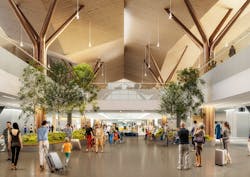The Future of Travel is on Display at Pittsburgh International Airport

To design a “next generation airport” one must look to the future, while still taking the time to understand the present. An integral part of the process is learning and experiencing what makes the airport’s region unique. What values set it apart?
Long before we begin to sketch out an airport design, we strive to live, know and understand the society. Experiencing and inhabiting everything that makes a community unique is the first step in the design process.
It was in 2015 when I first visited Pittsburgh. I was impressed with how vibrant the city felt, how green it was, and how lively and welcoming the people were. I completely fell in love with the city. Its magnetism was captivating, and I realized that one way or another, I would become part of this city.
Three years later, in July 2018, luis vidal + architects, along with Gensler and HDR, were selected to design Pittsburgh International Airport’s new terminal, which will consolidate PIT’s landside and airside operations into one facility adjacent to the current Airside Terminal.
The leadership team from Pittsburgh International Airport encouraged teamwork and collaboration from the onset of the project, noting that strong partnerships would be the key to a high-performing result.
To guide our work, I decided to move to Pittsburgh for two weeks. I studied the region by foot, on bicycle and by car. I wanted to discover the city and the region. I wanted to get lost. I wanted to speak with the city’s residents and visitors. I wanted to listen to the city’s rhythm.
So many things captivated me about Pittsburgh: its history, its pride, and the energy of a city able to reinvent itself.
We studied the region, taking inspiration from its rolling hills, rivers and green spaces. We also were inspired by its neighborhoods and communities, and the new economic diversity driving Pittsburgh’s renaissance.
When we started to sketch out drawings, we took the vivid experiences and information we had gathered. we worked on a vision: a pavilion in the middle of the forest. And we developed a concept with a unique DNA, with three chromosomes that encapsulate what made Pittsburgh and its region unrepeatable: its nature, its technology, and its community.
We started playing with an acronym that would contain the three concepts: “Co” for community, “Te” for technology and “Na” for nature; and we combined the three together, looking for the perfect sound: TeCoNa, CoNaTe… NaTeCo revealed itself to our ears and eyes as the best possible result.
But the word had to speak for itself. We wanted to go further. This is how we decided to give each concept a color. For “Na”, and representing Pittsburgh’s lush vegetation, we took the green color. “Te”, the regions’ robust technology (from healthcare industry to robotics and automobile sector), was powered by the blue color. And “Co”, the city and region’s magnificent and vibrant community, was encapsulated in copper.
This is how the new Pittsburgh International Airport terminal was inspired by remarkable greenery, tech renaissance and the people of the region, integrating seamlessly into the design of the existing Airside Terminal.
The resulting design is unique to Pittsburgh, incorporating regional characteristics and emulating natural elements. We used an undulating roof to match the identifiable “rolling” hills and brought organic-looking columns to the terminal’s interior. Local timber and ample plantings will be used throughout the interior as a nod to the region’s natural surroundings.
The design of the airport includes a new 700,000-square-foot terminal, parking garage and transportation complex designed to adapt to the latest technological improvements and automated systems in airport technology. The terminal will be the first in the U.S. to be built from the ground up in the new post-pandemic world.
Pittsburgh’s new terminal will be completely powered by its own microgrid with the use of on-site natural gas wells and nearly 10,000 solar panels across eight acres, a first for a major U.S. airport. Rainwater will be harvested to water the plants on the outdoor terraces. The airport will reuse/recycle at least 75 percent of the total waste generated by construction (a major portion of this reuse effort will come from crushed concrete).
Through our work at luis vidal + architects, we’ve seen just how crucial thoughtful design is when creating the “airport of the future.” We have – and will retain – a need to explore. It is the architect’s duty, then, to embrace innovation, effectively integrate the space into its surroundings and mirror each specific community. This will ensure that the user experience is excellent, seamless, and the airport will become the main gateway to region and city, with design able to leave a positive and lasting memory in every traveler.
About the Author

Luis Vidal
President and Founding Partner
Luis Vidal is the president and founding partner of Luis Vidal + Architects, a Madrid-based architecture practice with offices in Spain, the U.K., Chile, the Dominican Republic, and the U.S. Vidal offers responsible and quality designs in response to the urban and social challenges of the day. Notable projects include Heathrow’s award-winning Terminal 2 and several international airports in major U.S. cities, including Pittsburgh, Boston, Dallas and Denver.